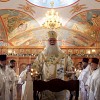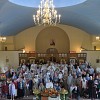In September of 2015, St Basil the Great parish in St Louis moved from a small rental space into its brand-new temple. Since then, the interior of the temple remained white with some blue in the dome and some areas of the ceiling and a variety of icons from the old temple and some new ones were hung on the walls. This arrangement could remain indefinitely, or an effort could be made to fresco the church. The main problem with the latter is that there are very few iconographers in the US. But of those few only a handful can work on the entire church. St Basil’s is a young community, and we still make mortgage payments on our temple and do not have an adequate church hall. But when several months ago the Divine Providence led us to meeting two iconographers who have the needed skills and experience, we knew we had to act.
During the Lenten Clergy Retreat in Chicago, Archbishop Peter gave his blessing for the start of the iconographic adornment of St Basil the Great Church in St Louis.
The work is done by Ivan Storchak and Roman Martynenko. They set it as the goal to make sure that the acrylic paints they are using would be as close as possible to the ancient frescos style and that the overall atmosphere of brightness which exists in St Basil’s would not be lost. Both Ivan and Roman hold degrees in art. They graduated from the Faculty of Graphic Arts at Kuban State University, Russia. Roman is a graduate of the Iconography Experimental Department of the Kuban University, a member of the Union of Iconographers of Russia, an instructor at the Kuban University. Ivan is a member of the Union of Artists of Russia, holds a Ph.D. in teaching. He is adjunct professor at the Graphics Class of the Art and Graphics Department at the Kuban University. Ivan and Roman participated in several significant iconography projects in Southern Russia and in the USA, with the Holy Prophet Elias Church in Krasnodar (which is on the UNESCO heritage list) being one of them. In the US, besides private projects, they frescoed three chapels at the Theotokos the Lifegiving Spring, a Greek Orthodox Monastery in Dunlap, CA, and a house chapel in Los Angeles.
When asked to share some of their thoughts regarding their work, here is what Ivan wrote: “St Basil the Great Orthodox Church in St Louis is acquiring one more language of communication: the temple is being adorned with frescos that will visually complete its interior appearance.”
It is traditional for Orthodox temples to be adorned with wall iconography. It is done to help one to prayerfully direct one’s attention to God and His saints, to be fully immersed in the worship.
Typically, the style of the iconography is determined by the architecture of the temple. St Basil the Great Church has the general architectural characteristics of a classic temple, cruciform in its plan. Built well, with beautiful proportions, the temple interior is pleasing to one’s eye and is perceived as harmonious. All of this leads one to think that the canonical iconography, in the Byzantine tradition, but in softer, more Russian application thereof, will suit this temple best of all.
Right now, what we called ‘Phase I’ is in progress: the iconography of the altar area. This includes "Christ Enthroned” in the High Place in the altar apse with the Theotokos and the angels against the gold background above the Saviour in the dome of the apse, while Holy Hierarchs Basil the Great and John Chrysostom are standing on either side of Christ.
The iconography in the dome of the church could be the next phase: (from the top down) the Pantocrator in the center of the dome, the synaxis of the archangels, prophets and ornamental pieces. Considering the overall concept, the plan should comply with the ancient traditions which specify that the narthex and the galleries have always been frescoed with the Lives of the Saints, the deeds of the holy apostles, i.e. the life of the Church. The upper levels of the temple have always been designated for the Lord God, apostles, angels and prophets.
The project is likely to take over two years, if there are no major obstacles. At the beginning of every new phase, a blessing from Archbishop Peter will be sought. We are in the beginning of an extremely important stage in the life of our parish which comes second only to the construction of the church itself. But, as we are doing it not for ourselves but for the glory of God, we hope our struggles will not remain without His almighty help.
|
| |||||||||||||














